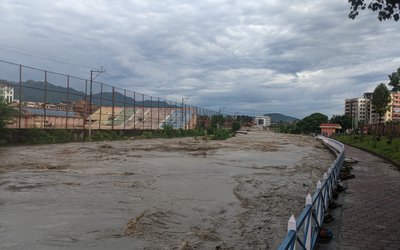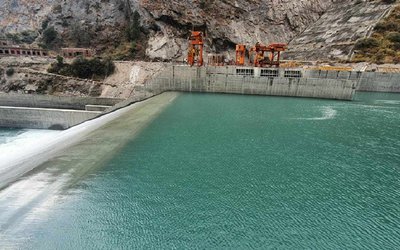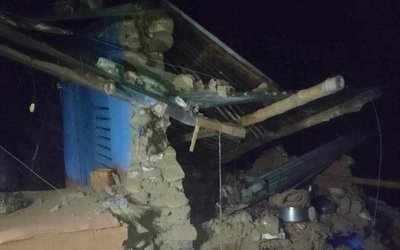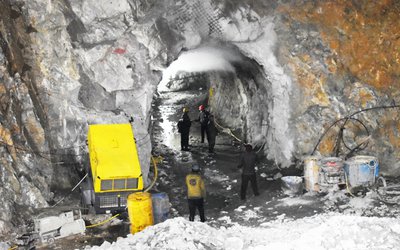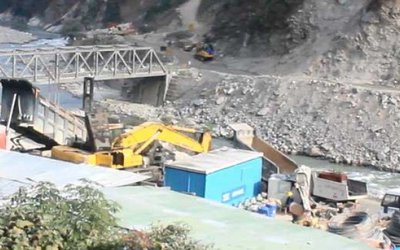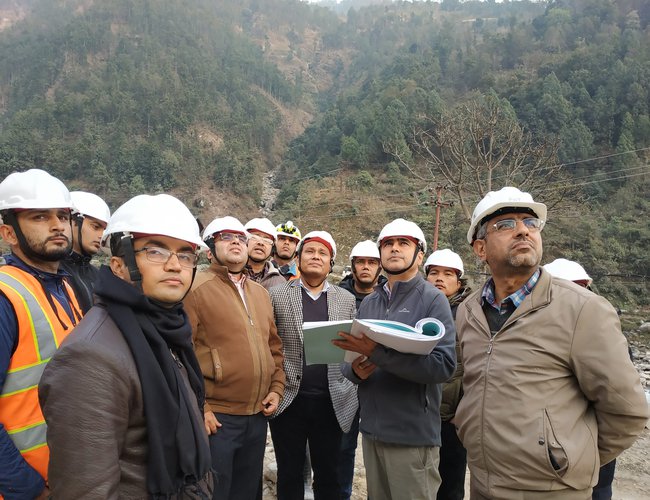
With the spread of COVID-19 and nationwide lockdown, many development projects are at a standstill. Thanks to the personal initiatives of Managing Director of Nepal Electricity Authority and Chairman of Trisuli Jal Vidhyut Company Limited Kul Man Ghising, the construction work in UT3BHEP has finally begun a few weeks ago. MD Ghising paid a visit to the construction site in March.
Although the pace is slow owing to labor and equipment inadequacy, the construction work is underway. Even in the crisis, around 20laborers and technicians, including 35 Chinese contractors, have been working in the project.
After his appointment as MD at NEA, Ghising has given high priority to Trisuli 3 A and 3 B projects. Following years of delay, 3A has already started generating a few months back.
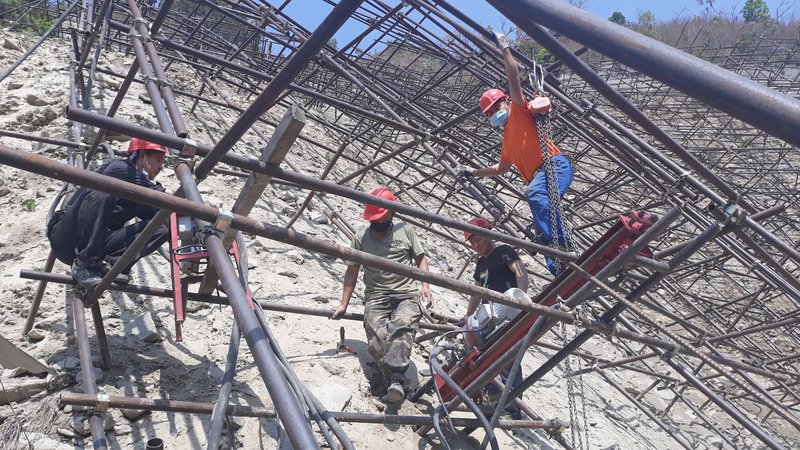
Project In Progress in lockdown: Work in slope
With MD Ghising’s leadership, Trisuli Jal Vidhyut Company Limited (TJVCL), jointly formed by Nepal Electricity Authority (NEA) and Nepal Doorsanchar Company Limited (NDCL) has handled all the works, financial closure, including the debt portion required for the project, contract agreement and launching of construction, successfully.
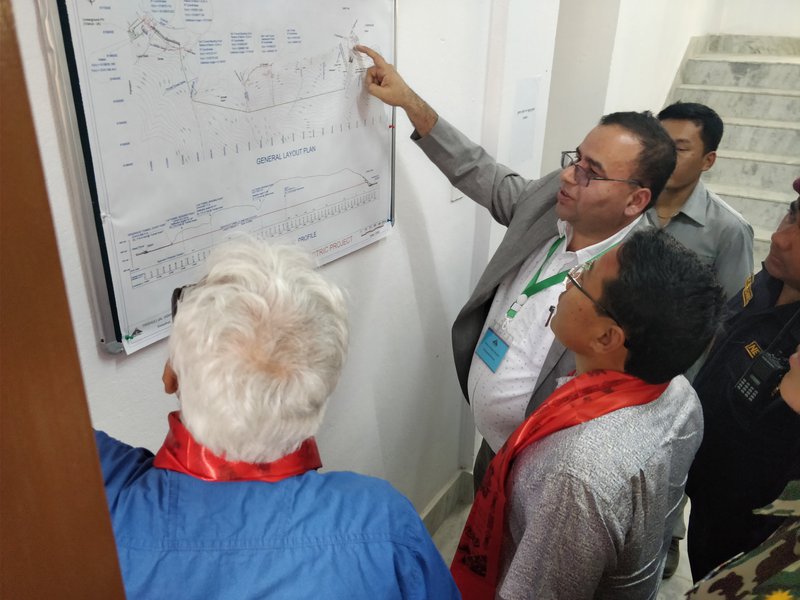
MD Gautam briefing Minister of Energy, Water Resources and Irrigation Barsha Man Pun about the project (File photo)
With proper guidance and committed management, the project has achieved every target completing over 40 percent work by the first week of January 2020 targeting to complete the project by 2021 March. However, the sudden upsurge of COVID-19, a global pandemic, in the middle of January has changed everything.
Led by Managing Director Mohan Prasad Gautam, who had a long experience working in the construction of projects, including 456 MW Upper Tamakosi and establishing Dudhkosi Storage Hydropower Project, Trisuli Jal Vidhyut Company Limited has begun construction work removing all possible hurdles to prevent delay in the project.
Complete backing from NEA’s management and the Minister of Energy, Water Resources and Irrigation, MD Gautam and his team have quite efficiently handled all the processes of construction of UT3BHEP.
With technical capacity and managerial experience in place, the plan of the project management perfectly worked before the outbreak of the COVID-19 pandemic. Commenced on 14 March 2018 with a target to complete by 13 March 2021, over 40 percent of work has completed till the first week of January. About 50 percent of underground tunnel work has also been completed.
However, everything had collapsed within a matter of a month. The progress of construction of 37 MW Upper Trisuli 3B Hydro Electric Project started to slow down following the COVID-19. In the last three months, the speed has drastically declined due to a shortage of labors and construction equipment.
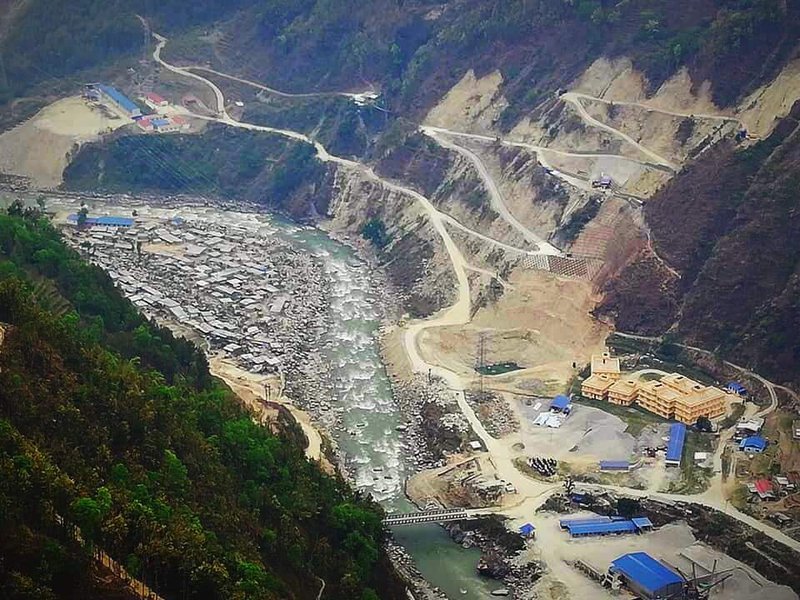
Trishuli 3 B project Site
The period from November to the first week of June is regarded as the best time to achieve progress in the civil and other surface construction work because of favorable weather. Following the onset of monsoon in June, progress will be slowed down naturally. However, the disruption started after January till now has pushed everything behind. Given the present scenario, there might be a delay of 6-8 months in completing the Project.
“Although the construction of the project was going on smoothly till the 3rd week of January 2020 and about 40% of the work had been completed by then, the COVID-19 has changed the status of the project,” said MD Gautam.
“The speed of the construction of the project started to slow down when the contractor sent his Chinese construction team back to China to celebrate Chinese New Year in the 3rd week of January 2020. The contractor planned to bring back its workers to Nepal in the first week of February 2020. Due to the outbreak of COVID-19 in China, the workers could not come back as planned,” said MD Gautam.
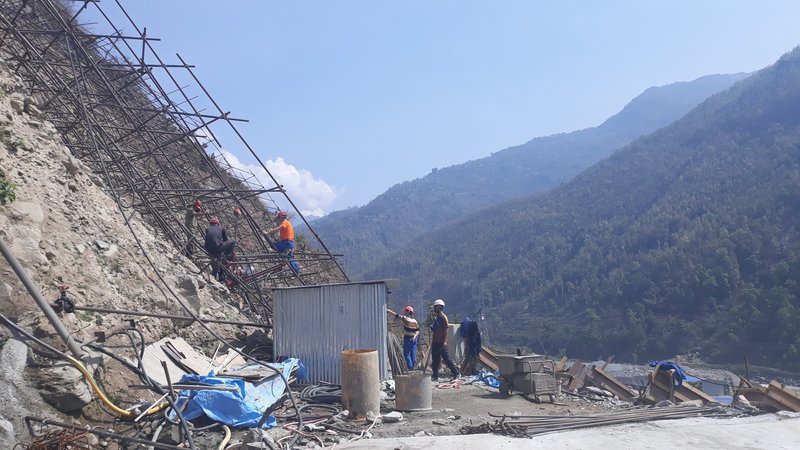
Labors are working
Promoted by TJVCL, a public limited company, UT3BHEP, which is situated in Nuwakot, is regarded as a financially sound project in terms of its location close to load center Kathmandu valley.
Constructed under national campaign Jantako Jalvidhyut 'Nepal ko Pani, Janata ko Lagani' (Nepal’s water, People’s investment), UT3BHEP is a project with Nepali investment. The rate of return of the project is higher for the strategically very important project to maintain energy supply to Kathmandu.
Given the modality of the project and high attraction, Prime Minister K.P. Sharma Oli, Minister for Energy, Water Resources and Irrigation Barsha Man Pun and other senior officials have also bought its shares. Out of 3.7 million shares issued to the public, Prime Minister Oli, his wife and minister Pun got 20 shares each.
With the installed capacity of 37 MW, a run-of-river (ROR) type cascade project of 60 MW Upper Trishuli 3A HEP, which lies in the Trishuli River, the project is a model of participation of government utilities, the general public, local development agencies.
Nepal Telecom and Nepal Electricity Authority have 30-30 percent promoter shares, local levels of Rasuwa and Nuwakot 5 percent, local financial institutions 5, People of Rasuwa and Nuwakot 10 percent, general public 15 and NEA and Telecom’s employees 5 percent.
The total cost of the project is estimated to be Rs. 7.44 billion with 7.8 billion projected interest of construction period. With 30 percent equity (2.47 billion) and seven percent loan (5.76 billion) through investment, the project will generate 134.8 million units of electricity in the dry season (November to June) and 157.7 million in the wet period (June to November).
Despite all obstructions, small scale activities are currently undergoing. The very small scale and the limited area will have a very insignificant contribution to accelerating the progress.
As the project has lost a lot of time during the valuable dry season of this year, it is now almost certain that the Powerhouse foundation work cannot be completed before the onset of monsoon although the first stage excavation is completed and slope support works including drilling, grouting and grid beam concreting are ongoing,
Once the monsoon starts, dewatering of the foundation pit, which is about 15m below the adjacent river water level, would be very difficult and concreting would be almost impossible.
Given the present scenario, powerhouse foundation work will not start before October 2020. However, the aim of completing the significant portion of the Powerhouse as per schedule appears difficult and challenging.
The project has been making all the efforts to resume the halted work and also to start new construction fronts. Earlier, the outbreak in China prevented the arrival of construction equipment/material and construction crew to the Site. Now, the nationwide lockdown in Nepal has prevented and further delayed the resumption of excavation from all fronts.
Although the construction equipment and materials are still stuck at Keyrung in China, the closure of the Nepal-China border at Rasuwagadhi has created obstruction.
Due to the lack of workers, excavation of Headrace Tunnel (HRT) was stopped from the 3rd week of January. As of now, powerhouse excavation and slope support work has continued as usual but the pace is slow. The Contractor resumed the excavation of HRT from inlet face on 4 March 2020 but it could not continue due to the nationwide lockdown.
Works that are in progress during a nationwide lockdown:
The Powerhouse slope support work including installation of soil nails and rock bolts and frame beam concreting;
Detailed design is of civil, hydromechanical and electromechanical components ongoing at full scale. a
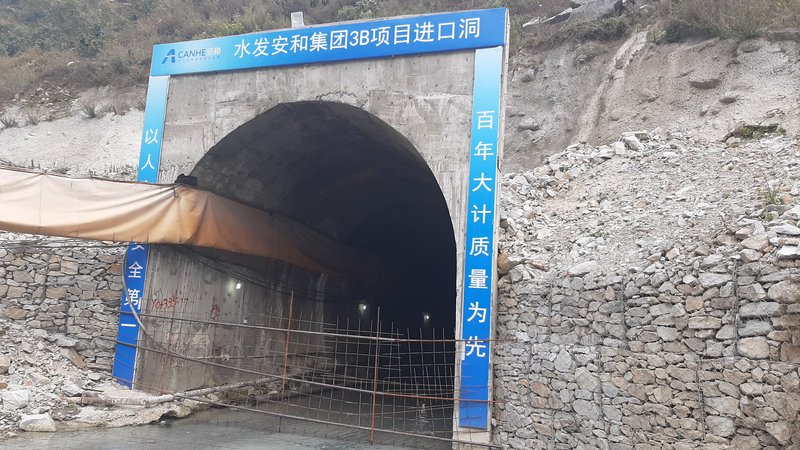
Audit Tunnel
Despite the terrible situation in Italy, ELC Electro-consult, Italy, has been working on design approval of civil, hydro-mechanical and electro-mechanical components of the project and contractual areas of the project from its home office in Milan.
The project management is also trying its best efforts for:
Resumption of tunnel excavation works with the help of the Nepali construction team;
Bringing to the site the contractor’s construction equipment, namely concrete pumps, shotcrete machines, generators, water stops and other accessories, stuck at Keyrung border. This has to be managed with coordination with top-level government authorities to open the border.
As has been recently informed from contractor’s head office, hydro and electro-mechanical equipment like Generators, Governors, Inlet Valve, Powerhouse Crane, Transformer, Excitation system, 132 kV switch station and Gate Hoist, etc are in procurement and manufacturing process in China.
As a batch of construction equipment and construction material has arrived at Keyrung at Nepal-China border, the Contractor is waiting for the border to reopen to bring that equipment to Site. The main construction crew from China will arrive at the site as soon as flights to China resume. Alternatively, the project management is also coordinating Contractors Head office to bring them by land route via Lhasa to Tatopani.
It is planned that as soon as the nationwide lockdown is relaxed, the work at various fronts like Approach Pressure Conduit, Powerhouse slope support, Surge tank slope support would be expedited.
The focus of the project is to bring it back on track and complete the construction without much delay by bringing the construction equipment and material stuck in Nepal China.
“We have been working to facilitate to bring the equipment from Kerung and finding the way to bring back more Nepali workers to push the project on the phase before January 2020,” said MD Gautam.
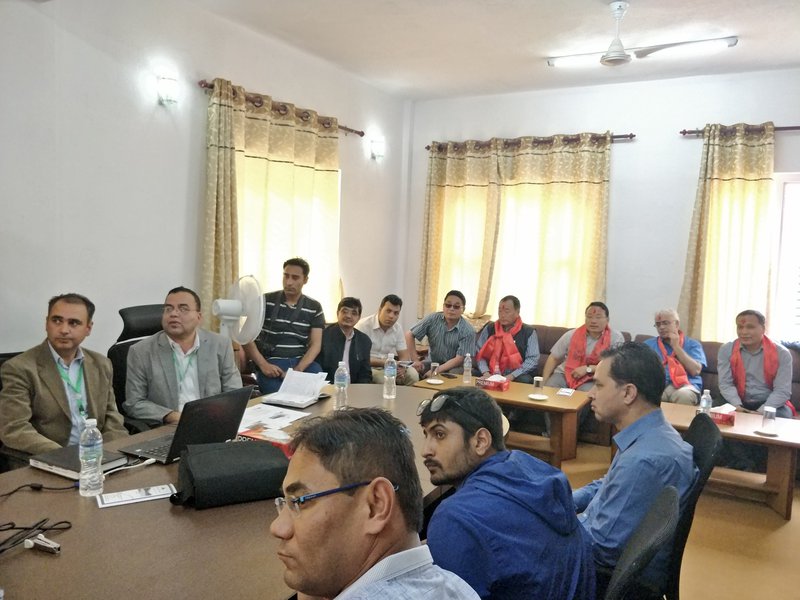
Given the current uncertain global situation and the country’s situation, even if everything moves as planned, the project will likely be delayed. NEA’s MD Ghising is making efforts to shorten the period of delay. In his effort, MD Ghising has started to facilitate the work to bring the equipment and materials lying in Keryung.
Salient Feature
SALIENT FEATURES OF UPPER TRISHULI 3B HYDROELECTRIC PROJECT
General
Location: -Kispang Rural Municipality (Nuwakot), Uttargaya Rural Municipality(Rasuwa)
Type of Scheme: - Run-of-River (Cascade of Upper Trishuli 3A Hydroelectric Project)
Gross Head: - 90 m
Installed Capacity: -37 MW
Average Annual Energy after Outage: 292.58GWh/year
Dry Season:- 134.88 GWh/ year
Wet Season:- 157.70 GWh/year
Penstock
Length: - 185.33m
Diameter: - 4.2m
Thickness: - 18 mm
Hydrology
Catchment Area: - 4577 km2
Design Discharge (at 70 % PoE): - 51 m3/sec
Powerhouse
Type: - Surface
Size (L X BXH): - 40.4 m x 19.30m x 33.81 m
Head Pond (Connected to UT3A Tailrace Pond)
Size: 29(L) x 5.2 to 11.0(B)x 7.35 to 14.8 (H)
Lowest Bed Level: - 714.20 m
Intake: - Bell Mouth Type
Tailrace Conduit
Type: - RCC
Length :- 180m (5.323 m (B) x 3.6 m (H))
Approach Pressure Conduit
Type: - Box Culvert
Length: -243.47 m + 40 m
Size: - 5.1m x 5.1m Square and 5.1 m diameter
Turbine
Type: - Vertical Axis Francis
Capacity: - 2X19.715MW
Headrace Tunnel
Shape: - Horseshoe
Length: - 3805.48m
Diameter: - 5.1m ~ 6.1 m
Generator
Type: - 3 Phase Synchronous
Capacity :- 2 X 22.7045MVA
Adit Tunnel
Shape: - Inverted D
Length of Adit 1: - 463.3 m, Diameter: - 4.0m +1.5 m
Length of Adit 2: 119.17m Diameter: -5.95 m ~ 6.1 m
Transformer
Type: - 3 Phase Oil Immersed Outdoor ONAN
Capacity: - 2X 23 MVA
Voltage Ratio:- 11 kV /132 kV
Surge Tank
Type: - Restricted Orifice
Diameter: - 15.0 m
Height: - 39.3 m
Transmission Line
Voltage Level:- 132 kV, Double Circuit (3 km)
Construction Period: -1095 Days from Commencement Date
Commencement Date: - 14 March, 2018
- Nepal-UK Tech Forum Held
- Jul 06, 2025
- Hari Sayani or Devshayani Ekadashi 2025: Day Of Tulsi Plantation
- Jul 06, 2025
- Siddhababa Tunnel Makes A Major Milestone
- Jul 06, 2025
- Weather Forecast: Generally Cloudy Across The Country With Heavy Rain At One Or Two Places Gandaki, Bagmati and Koshi Provinces
- Jul 06, 2025
- India’s External Affairs Ministry’s Senior Officials Says Indo-Nepal relations are ever expanding
- Jul 05, 2025
